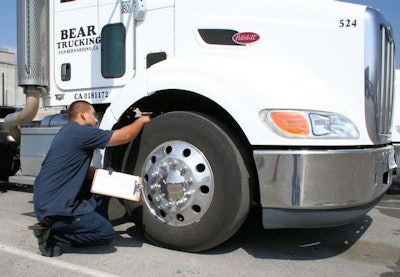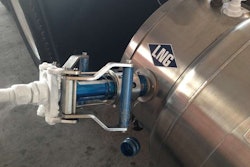 A technician for San Bernardino, Calif.-based Bear Trucking checks a Yokohama tire. As a tire rolls, there is less “squirm” with a shallow tread-depth tire than with a deep tread tire.
A technician for San Bernardino, Calif.-based Bear Trucking checks a Yokohama tire. As a tire rolls, there is less “squirm” with a shallow tread-depth tire than with a deep tread tire.No one’s gotten around to reinventing pine-scented air fresheners yet, but otherwise it seems that virtually every component or system found on today’s heavy-duty trucks is undergoing some sort of evolutionary change. Tires are no exception.
For profit-minded fleets, extending tire life always has been a priority. However, an increasing focus on fuel economy means that spec’ing tires simply for longer mileage no longer cuts it.
| Where do tires fit in fuel economy?Tire rolling resistance is the third-biggest factor affecting a vehicle’s fuel economy, says Rick Phillips, senior director of commercial and over-the-road tires for Yokohama Tire. For a typical Class 8 tractor at normal operating conditions, here’s where $1 worth of fuel goes:• 60% is wasted by engine inefficiency.• 21% is consumed by aerodynamic drag.• 13% is consumed by overcoming tire rolling resistance (average values vary according to tread type).
-15% by steer position* -35% by trailer position* -50% by drive position* •4% is consumed by the load. •2% is consumed by the drivetrain. A tire underinflated by 10 percent can result in a 20 percent loss in fuel economy, so even if a fleet does everything right, researches all of its options and chooses to run fuel-efficient tires, it won’t realize any benefit if it fails to keep them properly inflated. |
Today, low-rolling-resistance tires have become a prime tool in a fleet’s fuel-economy arsenal, and the results have been encouraging. Doug Jones, customer engineering support manager for Michelin, says low-rolling-resistance truck tires can contribute as much as 20 percent toward a vehicle’s fuel consumption performance.
But truck spec’ing often is a game of give-and-take. At first glance, it’s a given that low-rolling-resistance tires deliver superior fuel economy performance. But does that performance come at the cost of tire durability and longevity?
Fuel-efficient tire science
Three main factors impact a tire’s rolling resistance: tread compounding, tread pattern design and tire structure. “Tests show over 50 percent of the rolling resistance of a tire is generated from the tread and belt package,” says William Estupinan, vice president of technical service for Giti Tire USA.
Tire manufacturers develop tread compounding techniques to reduce the energy absorption and consequent heat generation within the tread and belt package while not compromising other important factors such as durability. These low-energy-absorbing materials sometimes are referred to as “reduced hysteresis” materials.
“The tread pattern design is also an important consideration when trying to improve the fuel efficiency of a tire,” says Estupinan, who lists other critical factors: streamlined ribs, blocks and lugs; good balance between cap and base compounds; shallower tread depth; and a stiffer belt package.
The dynamics of rolling resistance allow tire manufacturers to deliver greater fuel economy gains for truck fleets. “Like air resistance, rolling resistance increases with speed,” Estupinan says.
Part of a tire’s rolling resistance is its aerodynamic resistance as it moves. Even though rolling resistance doesn’t increase as fast as air resistance with an increase in speed, rolling resistance is present – and a major factor – at lower speeds.
 Pomona, Calif.-based KKW Trucking runs with Yokohama Tire’s Zenvironment low-rolling-resistance tires.
Pomona, Calif.-based KKW Trucking runs with Yokohama Tire’s Zenvironment low-rolling-resistance tires.Just as with air resistance, the actual amount of rolling resistance is influenced by many factors, including load, speed, inflation pressure, tread pattern and tire design. “Although fuel economy has a greater impact in high-speed long-haul operations, it plays a role even in high-load on-off operations,” Estupinan says.
Rick Phillips, senior director of commercial and over-the-road sales for Yokohama Tire, says different products have different tread depths for a reason. Depending on the application, steer tires go from 16/32- to 23/32-inch, drive tires can be from 22/32- to 32/32-inch, and trailer tires can go from 11/32- to 17/32-inch.
“Everything else being even, the tire with less tread depth is typically more fuel-efficient,” Phillips says. A deep tread tire will have more rolling resistance when it is new than it will when it’s half worn; that’s why tires don’t hit their fuel economy “sweet spot” until experiencing some road wear.
As a tire rolls, there is less “squirm” with a shallow tread-depth tire than with a deep tread tire, Phillips says. “The more squirm a tire has, the more horsepower is required from the engine to overcome its rolling resistance,” he says.
Deep treads tend to deform and squirm more and generate more heat than shallow treads as the tire rolls on the highway, Estupinan says. “A shallow-tread tire, like a trailer tire, typically has lower rolling resistance than a deeper drive pattern with blocks and lugs,” he says. “Another advantage of a shallow tread is that the initiation and expansion of irregular wear are less likely to occur as results of the reduced squirm.”
Changing the equation
While shallower tread depths equate to better fuel economy, it’s only natural for fleet managers to wonder about the impact these new designs have on tire life. Tire manufacturers such as Michelin are aware of this inherent tradeoff and are using modern technology to counter it, Jones says.
“The key is the different compounding and silicate makeups that each manufacturer has developed to enhance tire life,” he says. “The goal for all of us is to develop a more durable longer-lasting material to build tires with and deliver both low rolling resistance and longer life. Tires are not perfect products by a long shot. It’s a process of continuous improvement for us. We are constantly trying to improve our tires to get the lowest rolling resistance we possibly can without sacrificing performance and safety.”
Guy Walenga, director of commercial products engineering for Bridgestone Americas, says the fuel savings from low-rolling-resistance tires are real, and fleets must keep that in mind and learn a new formula for calculating tire costs.
“I hear fleet managers today say that by giving up tread wear, their cost per mile will go up,” Walenga says. “They’re right, but if their fuel economy has gone up 4 or 5 percent, they’re making money. Fleets that are buying fuel-efficient tires know tires costs are going up, and they also know that at the end of the year, their overall MPG number has increased from 6 or 7 percent up to 12 or 14 percent. They’re not getting the same cost per mile, though, because these new tires are designed for fuel economy, not mileage.”
Walenga counsels fleets that need a better understanding of the new fuel-efficient tire dynamic. “With conventional tires, it was easy,” he says: To determine cost per mile, divide the tire’s cost by its accrued mileage. Today, fleets have to incorporate fuel – in the form of fuel costs and gallons burned – into the equation.
“This new method gives you your total tire cost per mile,” Walenga says. “The first thing fleet managers say when they do the math is ‘That’s a bigger number,’ but it only looks big compared to the figures they’re used to seeing. The context of tire cost and fuel savings have to be built around that number.”
Getting the math right can have a huge positive effect on a fleet’s bottom line. “The largest expense for any trucking company is usually the cost of fuel,” Estupinan says. “In many cases, it can account for 39 percent of a fleet’s total expenses.”
According to studies conducted by Giti Tire, a single commercial truck can use as much as $70,000 worth of diesel a year, which translates to about 20,500 gallons.
“On a tractor-trailer combination, the steer tires contribute 15 to 20 percent to total tire fuel economy, drive tires 30 to 40 percent, and trailer tires about 40 to 50 percent,” Estupinan says. “Considering that trailer tires have the biggest impact on fuel economy and that trailer tires represent the biggest population in the average fleet in America, selecting the proper trailer tires for the fleet will have the biggest impact on miles per gallon consumed than any other wheel position.”
The first step is to use more fuel-efficient U.S. Environmental Protection Agency SmartWay-verified tires, starting with the trailer axles and continuing with steers and drives. “Following the math on these numbers, we see that a 20-truck/trailer fleet can save as much as $42,000 in a year simply by switching to SmartWay-certified tires,” Estupinan says.
Chris Han, commercial tire marketing manager for Kumho Tire, urges fleets to consider, evaluate, check and determine for themselves what tires work best for them. “They should do this by placing a few sets of tires on a trial basis, and following them through the first life and retread stage,” he says.
Fleets also should keep in mind that rolling resistance is only part of the fuel consumption picture, Han says. “Not all fleets are converts to wide-based single tires, yet tests have shown that they have the lowest rolling resistance and deliver the best possible fuel economy,” he says.









